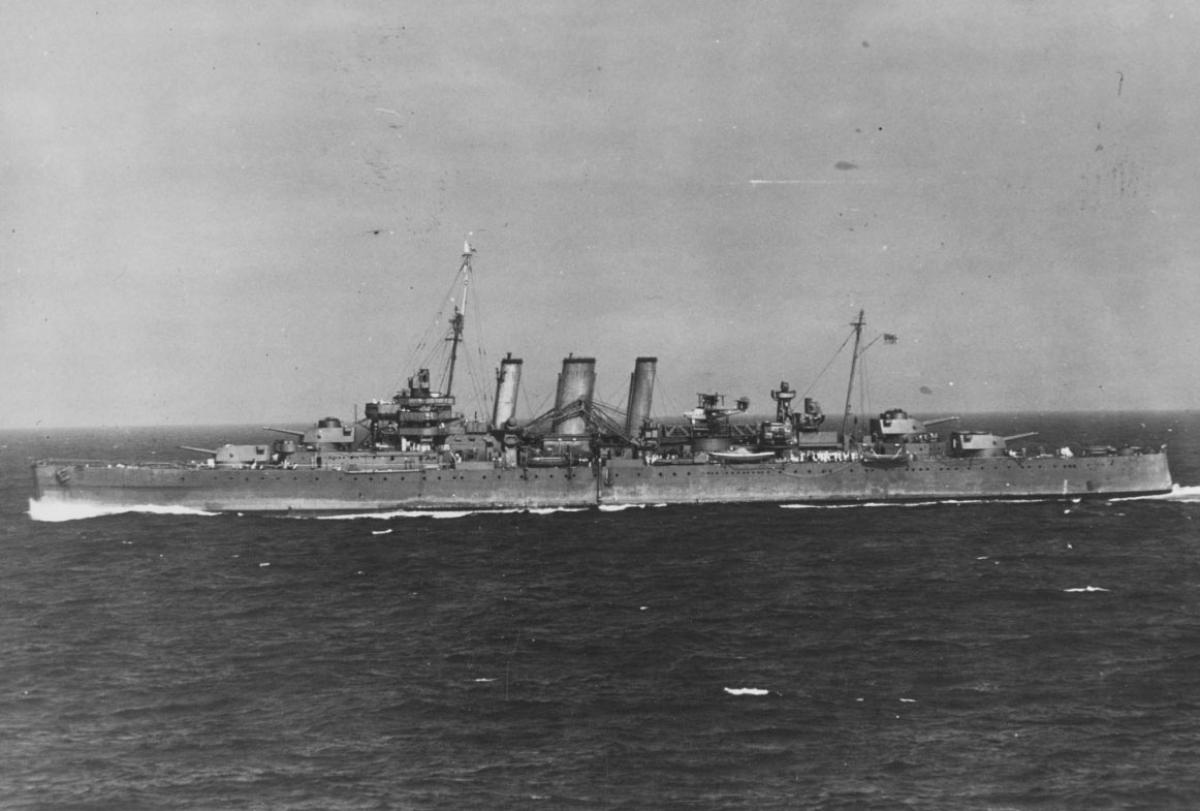In October 1944 near the Philippine island of Leyte, Japan unleashed a powerful, unforeseen weapon against enemy warships—the kamikaze. The heavy cruiser HMAS Australia received more than her share of attention from the deadly suicide planes. According to Australian sources, the cruiser became the first Allied ship hit by a kamikaze when on 21 October a D3A “Val” bomber struck her foremast, killing 7 officers—including her commanding officer—and 23 sailors. (Other sources deny the attack was a preplanned suicide attack.) That was just a taste of what was in store for the Australia during the January 1945 operation to invade the island of Luzon at Lingayen Gulf.
By the time the Australia and other Allied warships set out from Leyte Gulf for Lingayen, the heavy cruiser had undergone several wartime refits, which included substantially upgrading her antiaircraft (AA) armament. Following her latest refit, performed after the 21 October strike, her main weapons consisted of:
8 8-inch guns in four twin turrets
8 4-inch guns in four twin mountings
10 40-mm Bofors
7 twin 20-mm Oerlikons
While her 8-inchers would pound shore targets on Luzon, her antiaircraft guns would defend the ship against swarms of kamikazes—and the ship’s AA crews, in turn, would suffer grievous losses. Over five days of combat, five suicide planes would hit the Australia. What follows is an edited version of Captain John M. Armstrong’s action report on the activities of his cruiser during the Lingayen Gulf operation:
January 5th was a day of continuous air alerts, reports of as many as 69 bogies being received either from our own radar or from other ships, entailing 808 intership reports. This was perhaps not surprising as the force was passing up the west coast of Luzon and was within a radius of 120 miles of Manila during most of the daylight hours.
Late in the afternoon, a determined attack on the Rear Force was made. The raid was plotted in from 1715 to 1730, when a number of planes that had evaded the CAP [combat air patrol] attacked low from the west. At least six enemy planes were sighted on a relative bearing of Red 80, just above the water and were taken under fire by all ships. One was splashed abreast the destroyer screen, and one altered course to pass astern (what happened to it is not known). The remainder came in weaving low and fast despite intense AA fire. They crossed ahead of HMAS Australia, two within a hundred yards. One went on to score a hit on the Manila Bay(CVE-61). Another executed a very steep turn to the right, and ending in a vertical dive, hit HMAS Australiaon the port side of the upper deck amidships at 1735. The resulting fire was quickly subdued.
Material damage was slight; the only damage to the fighting efficiency was P.2 [port side, no. 2] 4-inch mounting out of action and Nos. 4 and 6 Bofors out of action. The major loss of fighting efficiency was due to casualties, there being some 25 killed and 30 wounded. These comprised the whole of P.2’s gun crew; 8 members of P.1’s gun crew; members of No. 2, 3, 4, 5, 6, and 10 Bofors; members of both port and starboard multiple Pom Poms; as well as most of the upper-deck ammunition supply parties.
Replacement gun crews were made up as follows: S.2’s gun crew took over P.1 (in order to have a fully trained 4-inch crew on each side). The remnants of P.1 were joined by 5 hands from Main Armament lower quarters to form a crew for P.2. Casualties on the Bofors and Pom Poms were replaced by Oerlikon crews, who in turn were replaced from 8-inch lower quarters, the remainder of the ammunition supply members, and certain fire distribution officers and ratings. P.2 remained without a proper crew and did not fire again except on D-day, when a scratch crew carried out the bombardment tasks.
At dawn on January 6th (D-3) the Mine Sweeping Group entered Lingayen Gulf supported by the Bombardment and Fire Support Group, which split into its two component parts: the Lingayen Fire Support Group and the San Fabian Fire Support Group. The latter (with HMAS Australia) proceeded to bombard targets on the east side of Lingayen Gulf.
At approximately 1436, the USS New Mexico(BB-40) was hit by a suicide plane for the second time, and from then on till dusk suicide attacks became frequent. About 1725, a number of enemy planes attacked and were taken under fire. At 1734, a D3A “Val” bomber dived on the ship from the starboard quarter and, flattening out, hit the ship on the upper deck between S.2 and S.1. This plane also carried a bomb, which from fragments found appeared to have been converted from a large caliber shell.
The resulting fire was quickly subdued. Material damage affecting fighting efficiency was confined mainly to the S.2 mounting. Both of its guns were put out of action, and all form of control destroyed. S.2 ammunition lockers were destroyed. Again, the major damage to fighting efficiency was through casualties. These were 14 killed and 26 wounded (the whole of S.2’s gun crew and most of S.1’s. Subsequently, there were only sufficient crews to man one 4-inch mounting on each side, a large proportion being casualty replacements.
On January 7th, the Mine Sweeping Groups carried on their tasks while the Bombardment and Fire Support Groups took up positions in support. Ship was in position by 0949, but there was little to do.
At dawn on January 8th (D-1), the whole force was moving into the gulf to carry out scheduled bombardments. At 0720 a two-engine plane (a Ki-46 “Dinah”) was sighted coming in low on the port quarter. HMAS Australia, last in the line, opened fire, and at the same time four patrolling F4F Wildcat fighters attacked. The Dinah was splashed 20 yards from the ship and skidded into the ship’s side doing little damage. One of the Wildcats followed the Dinah right in, despite ship’s fire, and the pilot was seen to bail out later.
At 0739, a second Dinah attacked from the same quarter and was put down just short of the ship but hit the ship on the waterline below the bridge. It carried a bomb that exploded short of or against the ship’s side and blew a 14-by-8-foot hole, opening a provision room and one oil tank to the sea. The ship took a list of 5 degrees to port, and adjacent compartments commenced to flood slowly. The list was corrected, flooding brought under control, and shoring up of bulkheads carried out. It was judged prudent to limit ship’s speed to 15 knots. There were only slight minor casualties, mostly shock, as a result of this hit.
Later in the day, while carrying out scheduled bombardment, it was noticed that the blast effect of firing our own guns forward on the port side was straining the inner bulkheads. It was decided not to fire the forward 8-inch on that side except in an emergency. At this stage, the destroyer screen was ordered to give HMAS Australia additional AA protection, and the USS Moale (DD-693) closed for the purpose.
At 0630 on 9th January, scheduled bombardments for D-day commenced, but HMAS Australia had no commitments till 0830. Between 0830 and 0930, when the first assault wave landed, we were able to fire all our commitments, except an assignment of 50 rounds of 4-inch with which our reduced 4-inch was unable to complete.
At 1311, two planes were sighted coming in from the east. One dived past the ship and hit the USS Mississippi(BB-41); the other came in from ahead after a curving dive and attempted to hit the bridge and fore controls. He however missed his aim, and diving under the fore yard, his wingtip caught on a mast strut, which swung him into the foremost funnel and over the side. There was no other material damage other than cutting off the tip third of the funnel, which necessitated closing down two boilers in the “A” Boiler Room, and damage to aerials, which was quickly repaired. There were no casualties.
Toward evening, HMAS Australia was directed to report to Carrier Task Force 79, and with the USS Columbia(CL-56), USS Louisville (CA-28), and destroyer HMAS Arunta was detailed to join the fast transport group returning to Leyte.
During the Lingayen operation, HMAS Australia was hit five times by suicide bombers. Except for the hole in the ship’s side and the casualties among AA crews, her fighting efficiency was not impaired beyond the capacity of temporary repairs.
For more about the 9 January 1945 landings on Luzon, read James Scott's article "Terror & Triumph at Lingayen Gulf," from the October 2018 issue of Naval History magazine.




![HMAS_Australia_Kamikaze_damage_IWM_A_29381[1]](/sites/default/files/styles/embed_medium/public/navalhistory/HMAS_Australia_Kamikaze_damage_IWM_A_293811.jpg?itok=cp3swag5)
